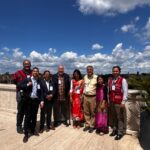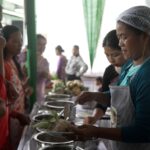
“We need to undertake some soul-searching to redefine the construction sector here and gain a deeper understanding of locally available materials and techniques,” stated Freddie A Wallang, a prominent architect in Shillong, emphasizing the importance of a culturally and environmentally grounded approach towards the construction sector in Shillong.
Wallang was addressing a stakeholders’ consultation conducted by the Alliance for an Energy Efficient Economy (AEEE) in collaboration with Barefoot Trust under the Vernacular and Innovative Construction Alternatives for Low-carbon Development Practices (VICALP) project, marking a significant step towards promoting sustainable building practices in Shillong.
The event aimed to bring together 20 architects, contractors, developers, and material suppliers to discuss the adoption of low-carbon alternatives in the construction sector. This consultation was recently held in BISCI, Laitumkhrah, the first of its kind co-working space in Shillong.
The consultation highlighted the challenges and opportunities in integrating low-carbon practices into Shillong’s construction landscape. Key issues included the availability, affordability, and structural feasibility of sustainable materials. These concerns resonated strongly with the participants, sparking dynamic discussions on how to overcome these barriers.
“Changing the mentality and mindset towards sustainable construction is one of the biggest challenges we face,” noted an expert during the session. This sentiment underscored the need for a shift in how both the industry and the public approach sustainability in construction.
Participants also highlighted concerns around the accessibility and affordability of sustainable materials. “The availability of sustainable materials is a huge challenge, and affordability remains a key concern,” said a contractor. The importance of developing local supply chains that can support the demand for eco-friendly materials at scale in the North East region is a key pivot point that needs to be explored further.
ALSO READ:
How local youth can become key actors in biodiversity conservation
Indigenous youth from Meghalaya discuss initiatives to enhance climate resilience in Rome

Another significant issue was the structural strength of some sustainable materials, which often limits their use to shorter-span buildings. “The structural strength of these materials needs more exploration to ensure they can be safely used for a wider range of projects,” remarked one of the architects
The session also addressed the broader need for capacity-building among stakeholders and the public to enable wider adoption of sustainable practices. “Building the capacity of the public and stakeholders is critical for driving these changes. We need to raise awareness about the potential of sustainable materials and their practical applications,” said an architect attending the event. A deeper understanding of local materials and their benefits is essential to overcoming the perception gaps that limit their use.
The session concluded with a call for industry-wide collaboration, innovation, and a reassessment of the current approach to construction in Shillong
Through initiatives like VICALP, Shillong is poised to lead the way in low-carbon construction, offering a model for other cities looking to transition to sustainable urban development. By fostering collaboration between industry stakeholders, the project seeks to create solutions that are not only environmentally sound but also economically viable and socially inclusive. The VICALP project seeks to integrate low-carbon materials and practices into the construction sector, reducing embodied carbon in building materials and processes. The initiative is working toward fostering a transition to sustainable, local building solutions, aiming to create resilient urban environments aligned with Shillong’s unique ecological and socio-cultural context over the next 3 years with a close focus on nurturing change with the various stakeholders.
By bringing together key industry players, this consultation aimed to foster collaboration, generate innovative solutions, and ensure Shillong’s transition to a greener, more resilient built environment.
ALSO WATCH:






